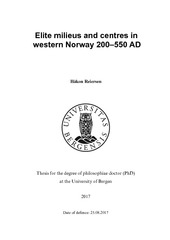| dc.description.abstract | This thesis examines how elite milieus organised their centres c. 200–550 AD in the counties of Hordaland and Rogaland, western Norway. Here, the archaeological material has many indications of elite organisation, which have been widely debated throughout the history of research. Building on insights from previous research, a general model of centre organisation was sketched. In the model, elite milieus, central functions and centre indicators were seen as interrelated components of the centre. Methodologically, centre organisation was approached through centre indicators – status objects and grand buildings – interpreted as being closely related to interaction between elite milieus and to the central functions gathered at centres. Previous work by Myhre and Ringstad identified where the centres in western Norway were located. After critically analysing the methods in their studies, their results were validated. Twelve of the identified centres in the study area were selected for detailed analysis of the local distribution of centre indicators. By using the general model of centre organisation and applying interpretations of the various centre indicators, the contexts for each of the centre localities were individually examined. The data set of all locations was then used to show general trends and variations in the organisation of the western Norwegian centres. The presence of sociopolitical, military, judicial and ritual central functions was identified at the examined centres. These functions were closely associated with the halls, retinues, thing sites and religion mentioned in contemporary or later written sources. Alliance networks between elite milieus at the centres have also been identified, best illustrated by alliances led by the Avaldsnes milieu in the late Roman period and by the Hauge-Tu milieu at Tinghaug in the Migration period. This thesis contributes to a better understanding of how societies were organised in the late Roman and Migration periods, and renews our view of elite milieus and centres. It actualises a large number of western Norwegian centres, connecting these localities to the extensive research discourse on Scandinavian centres. Although the western Norwegian centres have special regional characteristics, sites like Avaldsnes, Hove, Etne, Hafrsfjord and Tinghaug clearly resemble contemporary centres in Scandinavia. | en_US |
